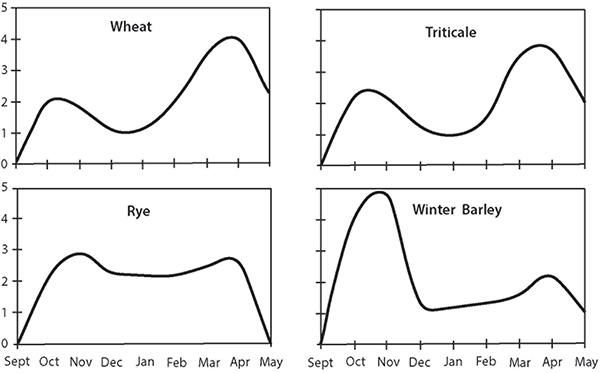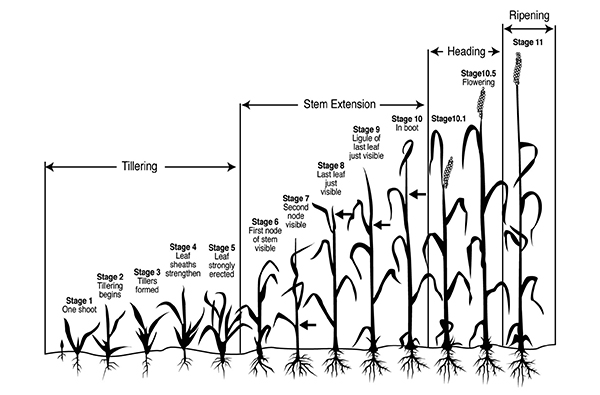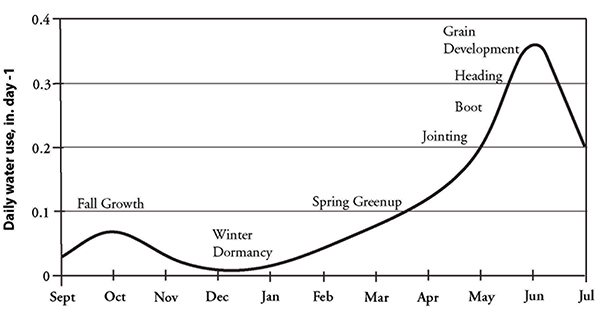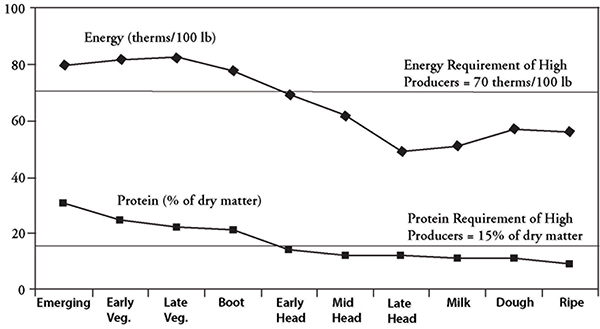Circular 630
Revised by Mark A. Marsalis
College of Agricultural, Consumer and Environmental Sciences, New Mexico State University
Author: Extension Forage Specialist, Agricultural Science Center at Los Lunas, New Mexico State University. (Print Friendly PDF)
Small grain crops are used extensively in New Mexico for various types of forage production and animal feeding situations (Figure 1). Due to the large presence of beef and dairy cattle operations, as well as a significant horse industry in New Mexico and the extent to which these operations utilize baled and ensiled feeds, there is a need for an informative guide to assist in management of small grains grown for forage. This publication focuses on cool-season, annual cereal crops grown specifically for use in both hay and silage systems. Their use for grazing is described in NMSU Extension Circular 695, Forage Selection and Establishment for Irrigated Pastures and Hay in New Mexico (https://pubs.nmsu.edu/_circulars/CR695/), and Circular 586, Irrigated Pasture Management in New Mexico (https://pubs.nmsu.edu/_circulars/CR586/).

Figure 1. Research plots of different wheat varieties grown at the NMSU Agricultural Science Center in Clovis, NM.
Small grains used to the greatest extent in New Mexico are wheat (Triticum aestivum L.) and triticale (× Triticosecale); however, rye (Secale cereale L.), barley (Hordeum vulgare L.), and oats (Avena sativa L.) are used to a lesser degree. All of these species have the potential to fill gaps between summer crops to supply year-round, high-quality forage to meet the varying nutritional demands of all classes of livestock. Wheat and oat hays are popular options in the horse and cow hay markets throughout New Mexico. In addition, growing small grains for silage with the intent to sell to local dairies gives farmers in eastern New Mexico a potentially more profitable alternative to grain harvest, depending on comparative crop market values. Small grains also serve as excellent cover crops that help prevent soil erosion and that take up significant amounts of soil nitrogen. Nitrogen uptake is particularly important in conjunction with the green water land application practices common with dairies. Interest in small grain crops will likely persist as livestock remain a critical component to New Mexico agriculture and as the year-round need to utilize liquid manure persists in this region of the United States.
Crop Selection for New Mexico
Wheat
Wheat is perhaps the best dual-purpose small grain crop and gives growers the greatest amount of flexibility with harvest and marketing options. Because there are established markets for wheat grain and storage facilities are readily accessible in the major wheat growing regions of the state, high market prices and good weather conditions have the potential to produce profits in any given year. On the other hand, if grain market prices are low, growers can decide whether it is more advantageous to sell their crop as hay or as silage for dairy consumption. By harvesting early for forage, disastrous weather conditions such as hail, drought, or high winds can be avoided, and double cropping becomes a possibility. If a producer has any interest in potentially harvesting for grain instead of forage, hard red winter wheats are recommended because white or soft wheats may not be accepted in traditional marketing channels.
Wheat has excellent cold hardiness and can be planted during a large time window in the fall. The majority of forage production occurs in the spring as the plant begins reproductive stages of growth (Figures 2 and 3). Although late plantings into October are possible, earlier plantings (e.g., mid-August/early September) usually result in higher yields and allow for greater productivity for fall grazing if that is part of the producer’s program (see Circular 586 for grazing management of winter small grains forages). Spring wheats can produce successful hay or silage crops when planted in the spring (or late winter at the southerly locations in New Mexico), and have been shown to yield from 3 to 6 tons/acre of dry matter. Winter wheat fails to head when planted in the spring unless it is planted early enough that temperatures are cold enough for adequate vernalization. Wheat is more sensitive to acidic soils than most of the other small grains and should be utilized on soils with a pH greater than 6.0. This is normally not a problem since most soils in New Mexico fall into this category. Wheat does not tolerate poorly drained conditions; for best productivity it should be grown on well-drained, loamy soils, although it can do well on sandy and clay soils.

Figure 2. Relative forage production distribution of small grain crops.

Figure 3. Feekes scale of wheat development. (Graphic by Jerry Downs. Adapted from Large, 1954.)
In general, wheat yields more dry matter than winter barley, similar amounts to oats, and slightly less than triticale and rye. In recent years, blends of wheat and triticale have performed better than wheat alone at variety trials in Clovis, NM. Oftentimes, variation from one variety to the next is greater than that of the variation between species, and it is important to know which varieties are best adapted to your area. Typical yields of wheat cut for silage range from 10 to 15 tons/acre (65% moisture). Wheat harvested as hay at the boot stage of maturity generally yields on average 5 tons/acre (range: 3–6 tons/acre), but this depends greatly on inputs such as water and fertilizer (Figure 3). For more information on varietal performance of small grain forages at Clovis, NM, visit https://clovissc.nmsu.edu/variety-trials.html.
Triticale
Triticale is a small grain cereal that was developed by crossing wheat and rye. Until recently, triticale was not grown extensively, mostly because of its inferior grain qualities for baking compared to wheat. In recent years, however, triticale has increased in popularity among forage growers looking for alternatives to wheat that may provide higher yields, more winter growth for grazing, increased nitrogen uptake, and better disease and insect resistance. It is now established that triticale can produce greater amounts of digestible dry matter while maintaining a nutritive value similar to that of wheat. As such, it is often the go-to winter forage for silage operations.
Triticale has a similar growth pattern to wheat (Figure 2). Because it is a cross between wheat and rye, there is a slight reduction of feeding value associated with triticale. However, varietal differences may have a greater effect than species selection on forage quality, and certainly in-season management (e.g., fertility, harvest stage) affects nutritive parameters more than anything.
Recent releases of triticale have exhibited yields much greater than those of wheat in certain locations of eastern New Mexico and western Texas under irrigation. Irrigated triticale typically yields greater than 13 tons/acre (65% moisture), and some varieties can produce as much as 20–22 tons/acre (https://clovissc.nmsu.edu/variety-trials.html). Triticale varieties that have performed consistently well at Clovis, NM, include ‘SlickTrit’, ‘ThunderTall’, and ‘Smoothgrazer’ (blend of triticale and wheat).
Triticale has larger leaves, stems, and heads than wheat and usually grows taller (Figure 4). As a result, triticale may require more wilting time at harvest. Triticale is later-maturing and remains green longer than wheat. Like wheat, both winter and spring triticales are available; however, spring types have not been extensively tested in New Mexico. Limited testing and producer observations indicate that spring triticales can also be grown successfully with high yields across New Mexico. Likewise, both awned and awnless (or awnletted, short awns) triticales are available. Certain varieties of triticale may exhibit improved resistance to diseases over wheat, such as leaf and stripe rusts and viral diseases.

Figure 4. Triticale (left) and wheat (right) planted on the same day at Clovis, NM. Note plant size difference and earlier maturity of wheat (heading).
Rye
Of all the small grains, rye is the most winterhardy and gives the most uniform growth throughout fall and winter (Figure 2). This makes it best suited for fall, winter, and early spring grazing where consistent forage production is required. Rye matures earlier than the other small grains, and quality declines rapidly in spring; hence, rye is not recommended for hay or ensiling unless it is harvested very early. Contamination of nearby fields that will subsequently be planted to wheat (grain) is always a concern with volunteer rye (potential dockage at the elevator); however, if it is grazed out or cut prior to heading for silage, the possibility of contamination is greatly reduced. Triticale is less prone to becoming “weedy” than rye. In general, rye has higher fiber content and lower digestibility and palatability than wheat, triticale, barley, and oat hay or silage due to a higher proportion of stems.
Barley
Historically, winter barley has been an inferior producer (hay/silage yield) of forage in New Mexico when compared to wheat and triticale, although newer releases are higher-yielding than in years past. On the other hand, barley produces the most nutritious forage of all the small grain cereals. It is lower in fiber and lignin and is characterized by higher crude protein and total digestible nutrients (TDN). This is likely a result of lower yields. Feed value is 90–100% that of corn. Relative forage quality (RFQ) values of over 200 are achievable with barley when harvested at boot stage. Although it produces high-quality hay and silage, barley is often lower in TDN per acre compared to wheat and triticale due to its low tonnage. Because barley has such high quality, harvest can be pushed later in order to increase yields while maintaining adequate nutritive value. As a result, barley is often harvested at the soft dough stage of grain fill. Irrigated trials at Clovis, NM, have indicated that when compared with wheat, triticale, and blends, barley competes better in dry years than when rainfall/irrigation amounts are moderate to high. Barley matures earlier than wheat and triticale, but later than rye. Consequently, it provides more early growth than wheat and triticale and can be grazed sooner. Also, barley is a very salt-tolerant crop (most tolerant of all cereal crops) and is recommended in situations where soil salinity is of concern (soil ECe greater than 4 dS/m) and on marginal soils that may not be suitable for most other crops. Both winter and spring types are available. Spring types are not winterhardy, and even some winter barleys may exhibit winter injury in severely cold conditions. Only a few barley varieties have been tested in New Mexico, and more testing is necessary in order to make reliable recommendations.
Oats
Spring oats are a good option for situations that require rapidly maturing forage production or when wheat productivity is low in spring. Oats have the potential to thicken up weak stands of wheat and will produce more forage than late-planted wheat. Quality of oats is similar to or greater than that of wheat at all growth stages, but yields will often be lower (~25–30% less) than from a well-established, fall-planted wheat stand. At boot stage, oat TDN can be 65% or greater. As with most forages, quality declines with maturity; however, many growers prefer to allow oats to reach the heading or grain fill stages of maturity before harvesting. While this increases yields, it dramatically reduces nutritive value, particularly crude protein and energy levels. This may be of little concern if the hay is directed toward the horse or cow hay markets.
Planting of spring oats should begin as early as possible after soil temperatures reach 45–50°F in the spring. Oats are particularly susceptible to barley yellow dwarf and other viral and fungal diseases. Resistant varieties should be considered, and management of disease hosts and vectors of spread is critical with oats. Some varieties that have performed well in New Mexico and western Texas in a one-cut system are ‘Charisma’, ‘Magnum’, ‘Monida’, ‘Troy’, and ‘Walken’ (Bean et al., 2004). ‘Walken’ is more of a “winter oat” planted in the fall. Forage growers should choose medium-long to very-long maturity varieties since these produce the most amount of dry matter. Short-maturity types are best suited for grain production. Spring oats can be planted in late summer to produce large amounts of forage in the fall, but will most likely winterkill in many areas of the state. While not the highest yielder, ‘Chilocco’ has been shown to survive winters in eastern New Mexico. The high cost of oat seed limits its use to a large degree. In some instances, oat seed may cost twice as much as wheat seed.
Production
Planting
As with any crop, success at harvest begins with using high-quality seed at planting. For wheat, a minimum test weight of 56 lb/bushel and germination of 85% or greater are recommended for proper establishment. Minimum acceptable test weights for triticale, barley, rye, and oats should be 50, 48, 56, and 32 lb/bushel, respectively. Although cheaper seed is appealing, it can cost more in the long run, and the quality of seed can mean the difference between a healthy stand and complete crop failure. For more information on seed quality, refer to NMSU Extension Guide A-131, Certified Seed (https://pubs.nmsu.edu/_a/A131/).
Small grains planted for forage production (grazing, hay, or silage) should be planted at rates about 25–30% higher than if planting for grain. For example, if a typical seeding rate for irrigated wheat grain in your area is 90 lb/acre, the corresponding forage rate would be about 110–120 lb/acre. By increasing the seeding rate, stem size is reduced, nutritive value is improved, and plants will dry faster and compact easier for baling and ensiling. This is particularly true with triticale, where stems tend be relatively large. For all the small grains, typical seeding rates range from 30 to 60 lb/acre for dryland and 75 to 120 lb/acre for irrigated crops. Very little improvement in forage yield has been observed with planting rates greater than 120 lb/acre.
Another important factor to consider is pest control. Early planted small grains are particularly susceptible to damage caused by various insects (e.g., wireworms, white grubs) and soilborne diseases (e.g., seedling blight). If grazing is not part of the program, it is recommended that planting be delayed until soil temperatures are low enough to reduce soil insect populations. Using seed treated with insecticides and fungicides will greatly reduce the risk of damage from soil insects and soil- and seed-borne pathogens that affect seedling plants. Several products are available for seed treatment, and many are effective on multiple insects and diseases.
All small grains should be planted into a clean, firm seedbed to promote good seed-to-soil contact, and into moisture for uniform germination (or irrigated soon after planting). Loose seedbeds can lead to poor/uneven emergence, winter injury, and seedling diseases. Optimal seeding depth is between 1.0 and 1.5 inches for most small grain crops (range: 0.75–2.0 inches). Seed planted less than 0.5 inch deep often results in uneven germination and seed desiccation due to soil drying. No-till seeding is possible with small grains, but residue management can be an issue and seeding depth may be more difficult to control. Drill equipment with some combination of specialized residue cleaners/coulters, down pressure mechanisms, and openers will most likely be necessary to adequately place the seed in heavy residue no-till situations.
Soil Fertility
Prior to planting, a soil test should be taken to assess the fertilizer requirements necessary to grow a high-quality forage crop (see NMSU Extension Guide A-146, Appropriate Analyses for New Mexico Soils [https://pubs.nmsu.edu/_a/A146/], and Circular 676, Interpreting Soil Tests: Unlock the Secrets of Your Soil [https://pubs.nmsu.edu/_circulars/CR676/], for more information on soil testing). Small grains respond well to nitrogen (N) applications, and fall tillering and forage production are promoted by adequate phosphorus. In double cropping systems, early plantings allow for uptake of residual nitrogen left in the soil from the previous crop, thereby minimizing leaching of nitrogen below the root zone and reducing waste. Total nitrogen amounts will depend on residual soil nitrogen and intended use of the crop. General recommended rates are 25–50% greater than the recommended 1.5 lb N/bushel of expected grain yield, or about 30–35 lb N per ton of dry forage yield (10–12 lb N per wet ton). Fertilizer rates will need to be increased and applied earlier if fall grazing is planned. Split applications are advised, and the majority (2/3 of total N) of nitrogen should be topdressed in spring prior to reproductive growth stages. Although season-long irrigations of effluent water result in consistent application of nitrogen through the plant’s life cycle, heavy applications early in the fall and winter (when crop growth is minimal) can lead to significant amounts of nitrogen leached out of the root zone and into groundwater resources.
In high fertility situations, lodging of triticale can occur, particularly if seeded at high rates (100 lb/acre or greater). Response to potassium fertilizer is not as great as the response to nitrogen and phosphorus, and most New Mexico soils are adequately supplied with available potassium. Exceptions to this rule may be in situations where large amounts of plant material have been removed from the land over many years (e.g., long-term alfalfa hay production). Occasional deficiencies of sulfur, iron, and zinc can occur, and appropriate rates of these elements can be determined from soil test results and recommendations. For potassium and micronutrients, it is recommended to follow up with a plant tissue test if soil tests indicate a deficiency. Soil and tissue tests are really the only way to properly determine which fertilizers are necessary and in what amounts.
Irrigation Management
Although excellent yields can be obtained in some years in dryland systems, small grains perform best under irrigation in New Mexico. In most years, yields can be nearly doubled with consistent and appropriately timed irrigation. Surprisingly, some small grains, such as wheat, can use nearly as much water as corn, and evapotranspirational demand can be as much as 30 inches per year. However, total seasonal water requirements typically range from 16 to 24 inches. Crops will use less water at higher elevations and cooler temperatures. Irrigation amounts need to be greater on sandier soils and at more southerly locations in the state.
If soils are dry throughout the potential rooting depth (3–4 ft) prior to planting, preplant irrigations may be necessary to begin building a good moisture profile for later growth after germination. Profile-filling irrigations are particularly helpful in the spring in order to supply adequate deep water just before rapid growth associated with jointing and later growth stages. A generalized, seasonal water-use curve for wheat is shown in Figure 5. Although water use increases in the fall as the plant establishes and tillers prior to winter dormancy, the majority of water use comes in the spring as growth resumes and as plants reach the reproductive stage. Peak water use occurs during heading and grain development. From jointing onward, adequate moisture is essential, and soil water availability should not be allowed to deplete below 50%.

Figure 5. Daily water use throughout the life cycle of wheat. (Adapted from Rogers, 1997.)
Variety trials conducted at the NMSU Agricultural Science Center at Clovis indicate that wheat and triticale harvested at the boot stage have varying degrees of irrigation water use efficiency (IWUE). Three-year averages show IWUE was 0.351 tons dry matter (DM)/inch applied (range: 0.222 to 0.449 tons DM/inch). As a group, triticale had higher IWUE than wheat. Local weather data may be helpful in determining irrigation scheduling and amounts to apply during the growing season. Plant evapotranspiration (ET) and growing degree day (GDD) information for many locations in New Mexico can be obtained at https://weather.nmsu.edu/coop/.
Harvest/Nutritive Value
Small grain hays can be an excellent, more economical, alternative feed for both cattle and horses where high-quality alfalfa is not needed. Under optimal growing conditions, harvest timing of small grain forages has the greatest effect on yield and nutritive value.
In general, it is recommended to harvest wheat and triticale hay at the late boot stage, prior to seed head emergence (or very soon after). At this stage, both yield and nutritive value are optimized. Total digestible nutrients (TDN) average about 60–70% at boot to early heading stage, and crude protein (CP) averages 15–16% (range: 12–20%) if adequately fertilized with nitrogen.
Harvesting prior to seed head emergence also prevents negative perceptions in the marketplace related to awns (or beards), which cause mouth irritations and ulcerations in livestock. Awnless varieties may help alleviate this issue and can allow for later harvesting to increase yield. Later harvests (e.g., during grain fill) will increase yields but will reduce hay quality (Table 1). Despite certain claims that beardless wheat is superior to bearded wheat in forage nutritive value, they are similar when harvested at the same growth stage. Overly mature hay may need to be ground up to break the stiff awns and to improve palatability for cows and horses. Market acceptance and class of livestock should be considered when determining when to harvest for hay.
Small grains can be difficult to dry after swathing due to their characteristically thick stems. This is particularly true if the windrows are narrow and heavy as a result of large quantities of plant material (Figures 6 and 7). Mower-conditioners or roller/crimpers are recommended to help break the stems and speed drying. Swathing into wider windrows also shortens drying time.

Figure 6. Windrowing triticale at boot stage for drying to proper moisture content for hay at Los Lunas, NM.

Figure 7. Bailing small batches of beardless wheat at Los Lunas, NM.
There are two different philosophies about the proper time to harvest for silage. Conventional thinking is that late boot/early heading is the best time to cut for silage because, as discussed earlier, energy and protein are optimized at this stage (Figure 8). At boot, cereal forages can meet the energy and protein demands of high-producing dairy cows. After heading, however, both components decline to levels that are too low to meet lactating dairy cow requirements if cereal forages are fed alone (Table 1). For some dairies and feedyards, this drop in quality is acceptable because they are adding energy and protein through other forms in the ration, and the small grain silage or hay does not constitute the total ration. Silage cut at soft dough and beyond may begin to limit intake rate of digestion as fiber levels increase to unacceptable levels. Small grain silage cut at boot stage contains higher crude protein than corn and sorghum silages, but less energy.

Figure 8. Energy and protein content of wheat harvested at different growth stages. (Adapted from Belyea et al., 1993.)
|
Table 1. Nutritive Value of Wheat and Triticale Forage as Affected by Plant Maturity (harvest date) at Artesia, NM |
|||||||||
|
Species |
Harvest Date |
Growth Stage |
DM* Yield (ton/acre) |
CP |
NDFD |
TDN (%) |
NEL |
Milk/ton (lb/ton) |
Milk/acre (lb/acre) |
|
Wheat |
Apr 14 |
Boot |
2.4 |
19 |
72.5 |
70.6 |
0.73 |
3598 |
8635 |
|
Apr 28 |
Flowering |
4.6 |
16 |
68.3 |
66.5 |
0.68 |
3273 |
15056 |
|
|
May 12 |
Soft dough |
6.6 |
13 |
62.1 |
63.0 |
0.65 |
2975 |
19635 |
|
|
Triticale |
Apr 14 |
Boot |
3.2 |
21 |
75.3 |
72.1 |
0.75 |
3723 |
11914 |
|
Apr 28 |
Flowering |
5.0 |
17 |
66.0 |
65.4 |
0.67 |
3177 |
15885 |
|
|
May 12 |
Soft dough |
7.4 |
14 |
57.7 |
60.8 |
0.62 |
2774 |
20528 |
|
|
*DM = dry matter, CP = crude protein, NDFD = neutral detergent fiber digestibility, TDN = total digestible nutrients, NEL = net energy for lactation. Source: F.E. Contreras-Govea. NMSU Small Grain Performance Trials, 2009. |
|||||||||
A second line of reasoning is that total crude protein and TDN and milk production per acre can be greatly increased by allowing the crop to mature to soft dough stage (Table 1). This is true because the increase in yield is enough to offset the decline in TDN percent of the field. Yields can be doubled by allowing cereals to mature from boot to soft dough. In New Mexico, where average dairy herd sizes exceed 2,000 head, producers may wish to maximize yield and TDN per acre rather than achieve the highest quality possible at boot. Whatever the case, overall nutritive value of the plant decreases from boot to flowering, and stem, fiber, and lignin proportions increase. As the plant matures from flowering to grain filling, a slight recovery in energy occurs, but not to the high level achieved at boot. This is due to highly digestible starch filling the head, and to an increase in head proportion of the total plant (Figure 9). Wheat maintains its quality slightly better than triticale throughout maturity, but triticale’s yield advantage often dictates its selection over wheat for high-input operations.

Figure 9. In vitro digestible dry matter (IVDDM) of small grain plant parts at various maturities. (Adapted from Cherney and Marten, 1982.)
Small grains harvested at boot stage or earlier will have a moisture content of about 80% and will have to be wilted to a target moisture of 60–65% for silage prior to chopping (Figure 10). Putting up silage with moisture levels of 70% or greater can lead to seepage and clostridial losses. Wilting time will depend on environmental conditions and stage of maturity. Waiting until the late dough (dry) stage of growth increases chances of poor ensiling resulting from improper packing and excess oxygen. Small grains have hollow stems and are more difficult to pack than corn and sorghum silages. They should be cut finer (3/8 to 1/2 inch) to ensure an adequate pack and oxygen exclusion. Rapid silo or bunker filling, packing, and covering is particularly important with small grain silages (Figure 11). Potential benefits from inoculants are greater with small grain silages than for corn or sorghum silages because native microbial populations are often low after winter, and this may be particularly important for silage cut early during cool periods.

Figure 10. Chopping wilted triticale to prepare for ensiling near Clovis, NM.

Figure 11. Tractor leveling and packing chopped triticale prior to ensiling.
Conclusions
Small grains will continue to remain an important source of feed in New Mexico for years to come. They have the potential to produce large amounts of nutritious forage for multiple types of feeding operations and can be utilized in many different ways. As information develops, NMSU’s Cooperative Extension Service will continue to provide updates on small grain management, and New Mexico county agent and specialist resources are always available to provide guidance on this subject. Visit https://aces.nmsu.edu/county/ to find your county’s Extension office.
References
Baker, R.D., S.T. Ball, and R. Flynn. 1997. Soil analysis: A key to soil nutrient management [Guide A-137]. Las Cruces: New Mexico State University Cooperative Extension Service. https://pubs.nmsu.edu/_a/A137/
Bean, B., and C. Trostle. 2004. Three year summary of spring oat varieties. Amarillo: Texas A&M AgriLife Research and Extension Center. Accessed April 2, 2018, at https://agrilifecdn.tamu.edu/amarillo/files/2010/11/Threeyearsummaryofspringoatvarieties.pdf
Bean, B., and C. Trostle. 2006. Considering spring planted oats [Pub. 5192]. Lubbock: Texas A&M AgriLife Research and Extension Center.
Belyea, R.L., R.E. Ricketts, F.A. Martz, R.R. Ruehlow, and R.C. Bennett. 1993. Wheat silage for dairy cattle [Pub. G3260]. Columbia: University of Missouri Extension.
Cherney, J.H., and G.C. Marten. 1982. Small grain crop forage potential: II. Interrelationships among biological, chemical, morphological, and anatomical determinants of quality. Crop Science, 22, 240–245.
Ditsch, D.C., and M.J. Bitzer. 1995. Managing small grains for livestock forage [Pub. AGR-160]. Lexington: University of Kentucky Cooperative Extension Service.
Glover, C.R. 1996. Certified seed [Guide A-131]. Las Cruces: New Mexico State University Cooperative Extension Service. https://pubs.nmsu.edu/_a/A131/
Glover, C.R. 1996. Know what is in a bag of seed [Guide A-216]. Las Cruces: New Mexico State University Cooperative Extension Service.
Large, E.C. 1954. Growth stages of cereals illustration of the Feekes scale. Plant Pathology, 3, 128–129.
Marsalis, M., B. Niece, A. Scott, R. Kirksey, and A. Mesbah. 2017. Winter annual small grain forages, variety performance reports 2011–2017. Accessed at https://clovissc.nmsu.edu/variety-trials.html
Mask, P.L., D.M. Ball, and B.R. Moss. 1994. Wheat silage production guide [Pub. ANR-528]. Auburn: Alabama Cooperative Extension Service.
Oelke, E.A., E.S. Oplinger, and M.A. Brinkman. 1989. Triticale. In Alternative field crops manual. Madison: University of Wisconsin Cooperative Extension.
Rayburn, E.B. 1995. Small grains as forage crops. Morgantown: West Virginia University Extension Service.
Rogers, D.H. 1997. Irrigation management. In Wheat production handbook (Pub. C-529; pp. 29–31). Manhattan: Kansas State University Cooperative Extension.
Watson, S.L., D.L. Fjell, J.P. Shroyer, K. Bolsen, and S. Duncan. 1993. Small grain cereals for forage [Pub. MF-1072]. Manhattan: Kansas State University Cooperative Extension.
For further reading
CR-641: Hay Quality, Sampling, and Testing
https://pubs.nmsu.edu/_circulars/CR641/
CR-642: Silage Microbial Inoculants: Use in Hot Weather Conditions
https://pubs.nmsu.edu/_circulars/CR642/
CR-665: Survey of Silage Crop Nutritive Value in New Mexico and West Texas
https://pubs.nmsu.edu/_circulars/CR665/

Mark Marsalis is an Extension Agronomist in the Department of Extension Plant Sciences at New Mexico State University. He earned his M.S. at the University of Tennessee and his Ph.D. at Texas Tech University. His Extension and research interests include efficient and sustainable management of irrigated forage crops and dryland grain crops to maximize yields in limited water situations.
To find more resources for your business, home, or family, visit the College of Agricultural, Consumer and Environmental Sciences on the World Wide Web at pubs.nmsu.edu
Contents of publications may be freely reproduced for educational purposes. All other rights reserved. For permission to use publications for other purposes, contact pubs@nmsu.edu or the authors listed on the publication.
New Mexico State University is an equal opportunity/affirmative action employer and educator. NMSU and the U.S. Department of Agriculture cooperating.
Revised August 2018 Las Cruces, NM


